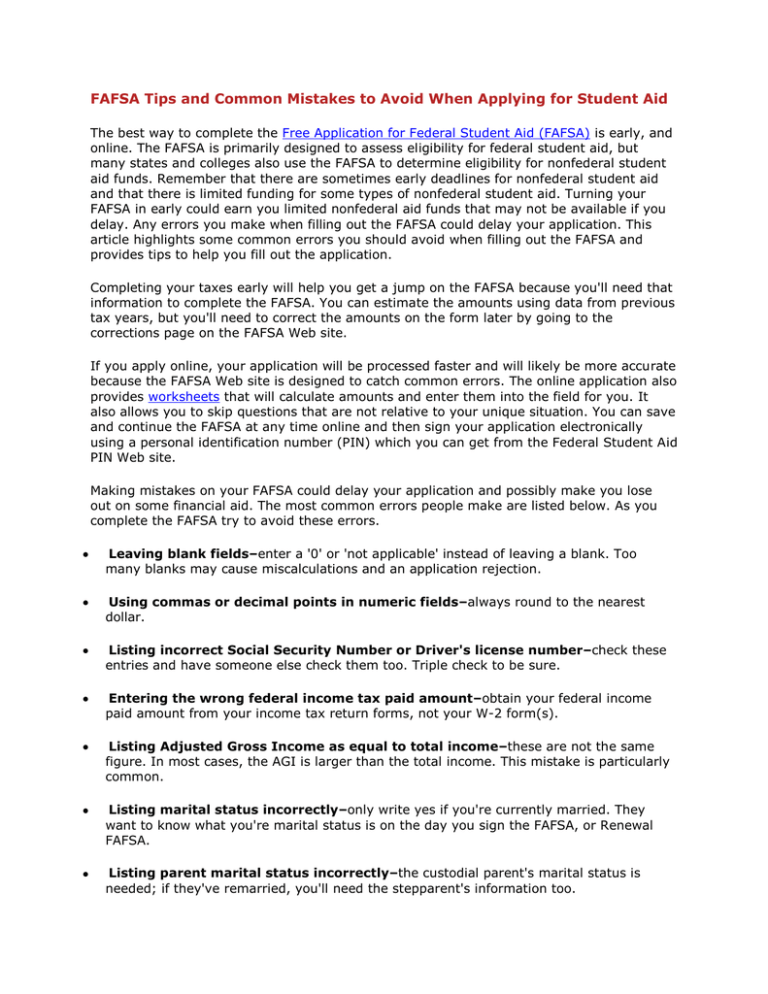FAFSA Tips and Common Mistakes to Avoid When Applying for
advertisement

FAFSA Tips and Common Mistakes to Avoid When Applying for Student Aid The best way to complete the Free Application for Federal Student Aid (FAFSA) is early, and online. The FAFSA is primarily designed to assess eligibility for federal student aid, but many states and colleges also use the FAFSA to determine eligibility for nonfederal student aid funds. Remember that there are sometimes early deadlines for nonfederal student aid and that there is limited funding for some types of nonfederal student aid. Turning your FAFSA in early could earn you limited nonfederal aid funds that may not be available if you delay. Any errors you make when filling out the FAFSA could delay your application. This article highlights some common errors you should avoid when filling out the FAFSA and provides tips to help you fill out the application. Completing your taxes early will help you get a jump on the FAFSA because you'll need that information to complete the FAFSA. You can estimate the amounts using data from previous tax years, but you'll need to correct the amounts on the form later by going to the corrections page on the FAFSA Web site. If you apply online, your application will be processed faster and will likely be more accurate because the FAFSA Web site is designed to catch common errors. The online application also provides worksheets that will calculate amounts and enter them into the field for you. It also allows you to skip questions that are not relative to your unique situation. You can save and continue the FAFSA at any time online and then sign your application electronically using a personal identification number (PIN) which you can get from the Federal Student Aid PIN Web site. Making mistakes on your FAFSA could delay your application and possibly make you lose out on some financial aid. The most common errors people make are listed below. As you complete the FAFSA try to avoid these errors. Leaving blank fields–enter a '0' or 'not applicable' instead of leaving a blank. Too many blanks may cause miscalculations and an application rejection. Using commas or decimal points in numeric fields–always round to the nearest dollar. Listing incorrect Social Security Number or Driver's license number–check these entries and have someone else check them too. Triple check to be sure. Entering the wrong federal income tax paid amount–obtain your federal income paid amount from your income tax return forms, not your W-2 form(s). Listing Adjusted Gross Income as equal to total income–these are not the same figure. In most cases, the AGI is larger than the total income. This mistake is particularly common. Listing marital status incorrectly–only write yes if you're currently married. They want to know what you're marital status is on the day you sign the FAFSA, or Renewal FAFSA. Listing parent marital status incorrectly–the custodial parent's marital status is needed; if they've remarried, you'll need the stepparent's information too. Leaving the question about drug-related offenses blank–If you're unsure about something, find out before you submit your FAFSA instead of leaving it blank. A conviction doesn't necessarily disqualify you from getting aid. Forgetting to list the college–obtain the Federal School Code for the college you plan on attending and list it–along with any other schools to which you've applied. Forgetting to sign and date–if you're filling out the paper FAFSA, be sure to sign it. If you're filing electronically, be sure to obtain your PIN from www.pin.ed.gov. Your PIN is your electronic signature and will always be assigned to you only. Entering the wrong address–your permanent address is not your campus or summer address. Sending in a copy of your income tax returns–you will be contacted if your information needs verification; you don't need to send a copy of your tax returns in with your application. Additional Tips Much of the financial information you need to provide is on your tax forms. Completing your taxes early can make the application process easier because you'll have the financial information you need in one place. You can estimate your financial information using previous tax years and correct the amounts on the form later by going to the corrections page on the FAFSA Web site. If you are not required to file taxes you still have to fill out a FAFSA to get financial aid. Here is a list of materials that will help you complete the FAFSA: Your Social Security Number (can be found on Social Security card) Your driver's license (if any) Your W-2 Forms for the previous year and other records of money earned Your (and your spouse's, if you are married) most recent Federal Income Tax Return – IRS Form 1040, 1040A, 1040EZ, 1040Telefile, foreign tax return, or tax return for Puerto Rico, Guam, American Samoa, the U.S. Virgin Islands, the Marshall Islands, the Federated States of Micronesia Your parent's Federal Income Tax Return for the previous year (if you are a dependent student as defined by federal criteria) Your current bank statements Your current business and investment mortgage information, business and farm records, stock, bond, and other investment records Documentation that you are a U.S. permanent resident or other eligible noncitizen. Filling out the Pre-Application Worksheet will help you collect and proofread the information for your application before you submit it. There are resources available if you decide you need assistance filling out the FAFSA, check the FAQ section on the FAFSA Web site, or call the Federal Student Aid Information Center at 1-800-4-FED AID (1-800-433-3243). Financial aid administrators across the country also participate in free FAFSA events to help applicants fill out the form accurately. Look for a FAFSA event in your area to get free, professional assistance to fill out the FAFSA.
